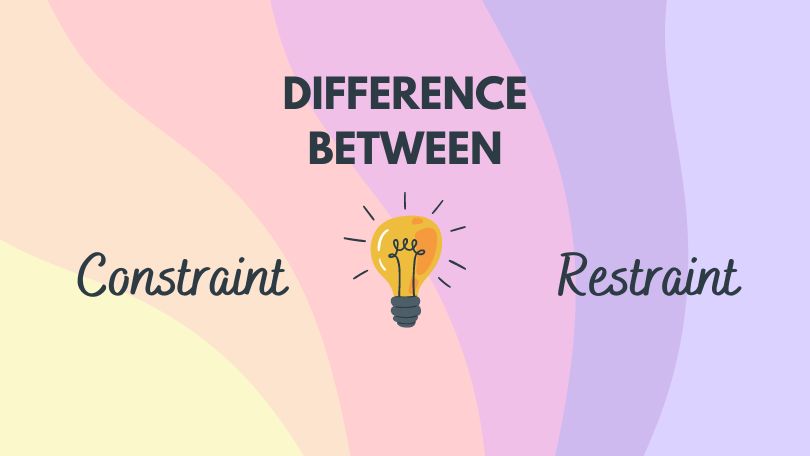When the term “restraint” is seen in any sentence, it implies limiting something or someone by exerting force to keep them under control. When you place a limitation on something or somebody, it is similar to what we call ‘constraint’. The distinction between these two words becomes even clearer when talking about physics or mathematics.
Constraint Vs. Restraint
Restraint and Constraint have an interchangeable meaning in the sense that constraint means to impose a restriction over any action, whereas Restrain, mostly used as a verb, means to hold something back.
So, “restraint” is the prevention of an act through certain control mechanisms. We could call this what it really is – a constraint. While “constraint” refers to limitations that deter our liberty to act freely or in such a way that we are not able to do so easily and quickly under normal circumstances.
What is Constraint?
Restrictions on an individual- those that limit one’s freedom- are typically referred to as constraints. In certain situations, constraints can limit the actions of individuals. The word ‘constraint’ stems from the French term constraindre, which means to limit or obstruct certain actions.
It is a constraint if there are external factors that dictate how we should live our lives. Our values and morals usually come from outside sources- people, books, or the media. Constraints can also arise from personal beliefs and assumptions about what is right or wrong. There are a variety of origins for constraints, ranging from financial to political to social. Constraints can also come from legal and other domains of life.
One could use the word ‘constraint’ to describe how one’s relations with another can be limited. Another meaning in math is to denote an absolute restriction in an equation. Instances where the word ‘constraint’ is usually used in English:
- His family is currently living under serious financial constraints.
- His mother constrained his freedom.
What is Restraint?
The word “restraint” is derived from the old French word retraindre, which literally translates to “to stop”. The word connotes the use of force to restrain someone. Things like “restraints” imply certain commonly used measures to delimit the actions an individual can perform, which are usually things like handcuffs or chains.
Restraint is also about self-control. When most people restrain themselves, it means they regulate and curb their own behavior. Restraint generally describes a situation in which people show careful patience and discretion in a manner that doesn’t allow them to follow their natural impulses.
Furthermore, the word can also be used to indicate article safety products like seat belts. In such situations, ‘restraint’ should not be changed by ‘constraint’. Some instances of using the word ‘restraint’ in sentences are illustrated below:
- It might be required to put him in restraints.
- He abandoned his restraints in order to express his anger.
Major differences Between Restraint and Constraint
- Constraints and restraints differ in terms of the connotation that each term has in conversational English. The word ‘constraint’ is often used to refer to something that is seen as an undesirable limitation of one’s freedom of action, while the word ‘restraint’ can be used with describing something that helps you control your actions.
- The origin of these two words is different. ‘Constraint’ comes from the French word “constraindre” which means to limit a person’s behavior. ‘Restraint’ has a similar meaning, coming from “restraindre” which holds people back.
- The term ‘constraint’ is used more often in cases where there is a problem or limit imposed on someone. Restraint is often used to imply the action of holding something back or limiting a person from doing certain things.
- When it comes to the subject of scientific discipline, the term ‘constraint’ is used to refer to a restriction given on any given calculation of mathematics, ‘Restraint’ refers to the bias that is forcing this equation to yield a specific answer.
- The term ‘constraint’ can’t be used as a replacement for ‘restraint’ in the context of safety devices and tools, including seat belts.
Conclusion
The difference between the words “constraint” and “restraint” is sometimes ambiguous. We want to clarify what they mean so that you know when to use which one.
A constraint limits the freedom of action and is usually in the form of an obligation. For example, a law could be called a constraint because it limits people’s actions. The word restraint has two very different meanings. The first one implies that the subject is being controlled or held back, while the other just means that they are limited to certain actions. Generally, the former is used in context with difficult & complex tasks, while the latter connotes the use of control mechanisms to prevent an individual from performing an action.
These words can be understood in different contexts, including science. However, their meaning in mathematics is completely different. Similarly, their origins are unrelated as well.

